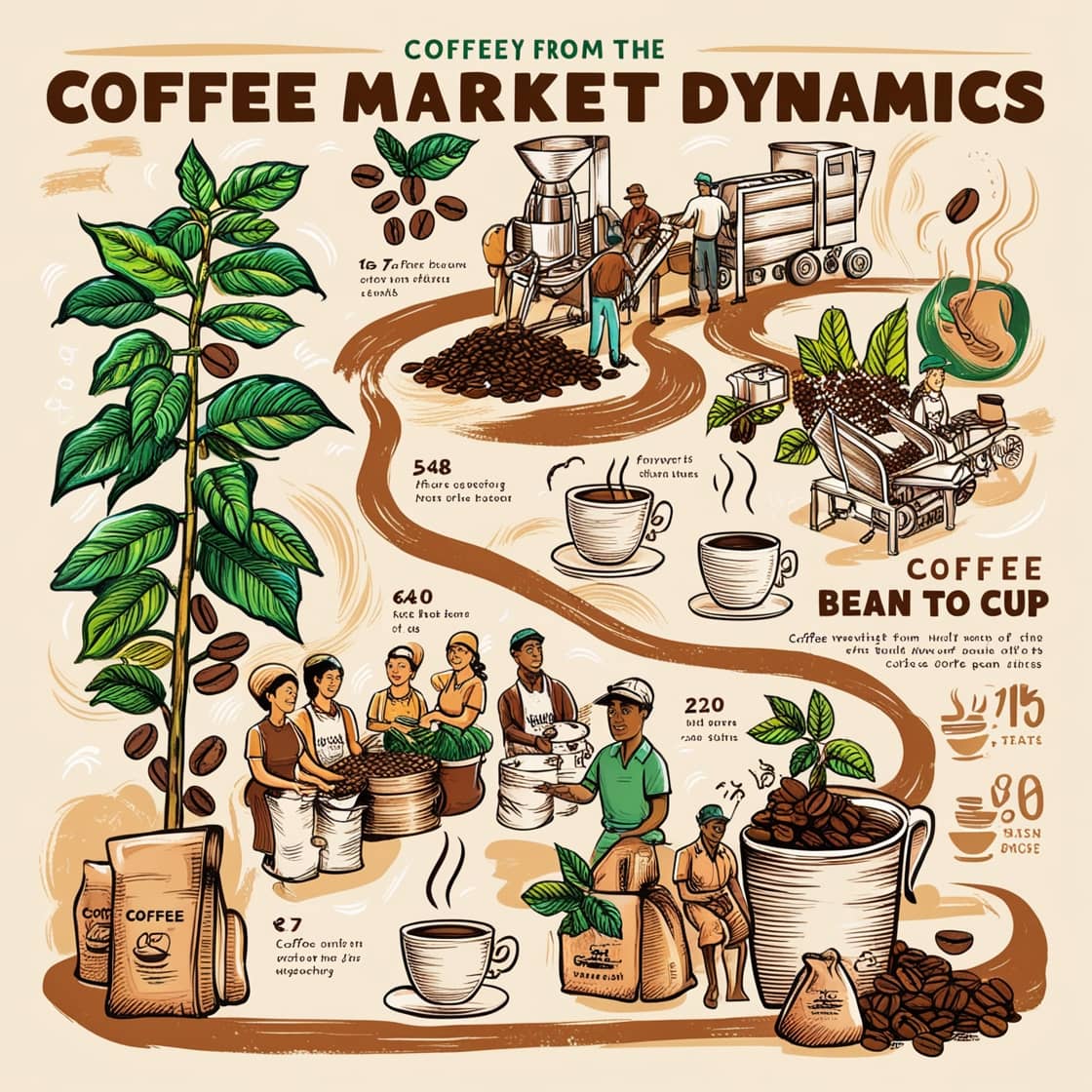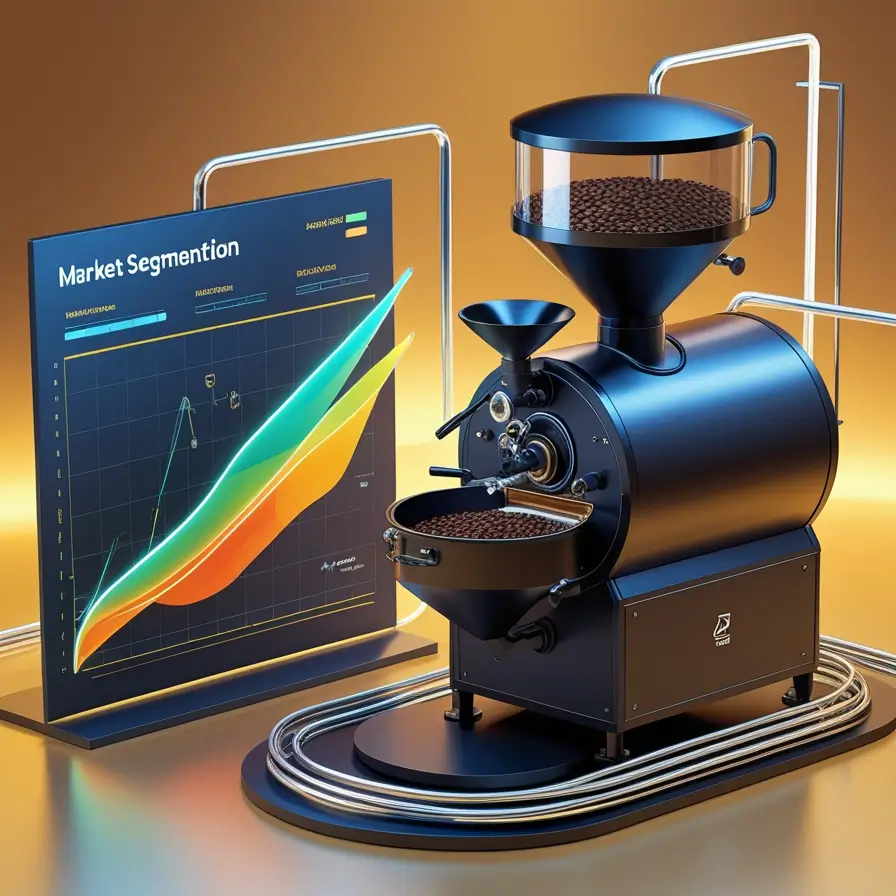Coffee Market Dynamics From Bean to Cup: 15 Powerful Insights into a Global Phenomenon

The global coffee market is a complex, multifaceted ecosystem that transcends mere beverage production, representing a sophisticated interplay of agricultural innovation, economic dynamics, cultural exchange, and technological transformation. Coffee Market Dynamics From Bean to Cup is not just a narrative of commodity movement, but a comprehensive exploration of an industry that profoundly impacts global economies, social structures, and consumer experiences.
Annually, over 2.25 billion cups of coffee are consumed worldwide, creating an economic network that involves millions of farmers, traders, roasters, retailers, and consumers across continents. This intricate system represents more than a simple supply chain—it’s a dynamic, living ecosystem that continuously evolves through technological innovation, changing consumer preferences, and global economic shifts.
1. The Global Coffee Journey: coffee market dynamics from bean to cup

☕️ Witness the artistry of traditional coffee farming, where each terrace tells a story of dedication and craftsmanship
🌱 From sun-kissed cherries to global markets
🏔️ Sustainable farming at its finest: Where tradition meets modern coffee demands
Detailed Exploration of Coffee’s Transformative Path
The journey of a coffee bean is a remarkable narrative of transformation, involving complex processes that span multiple continents and engage countless human touchpoints. From the moment a coffee cherry is hand-picked in a mountainous plantation to its final metamorphosis into a meticulously crafted beverage, each bean carries a unique story of origin, cultivation, and global traversal.
Key Insights and Comprehensive Analysis:
- Botanical Origins: Coffee originates primarily from two species—Arabica (approximately 60% of global production) and Robusta (40%)
- Global Production Landscape: Over 50 countries participate in commercial coffee production
- Geographical Diversity: Coffee grows in regions spanning multiple continents, each offering unique terroir and flavor profiles
- Economic Significance: The global coffee trade involves an estimated 25 million farming families
- Intricate Transportation: An average coffee bean travels more than 5,000 miles before reaching final consumption
2. The Foundation of Production: Growing Regions and Climate Impact

🍒 Exploring the Delicate Art of Coffee Cultivation
🌿 Climate, Care, and Craft: The Hidden Story Behind Every Cup
🌄 Sustainable Agriculture Meets Artistic Inspiration
Comprehensive Analysis of Coffee Cultivation Ecosystems
Coffee production is intricately linked to specific geographical and climatic conditions, with the equatorial “Coffee Belt” providing optimal environments for cultivation. This region, stretching between the Tropics of Cancer and Capricorn, represents a delicate ecological system where altitude, rainfall, temperature, and soil composition converge to create ideal growing conditions.
Detailed Production Insights:
- Primary Production Regions:
- Latin America (Brazil, Colombia, Honduras)
- Africa (Ethiopia, Kenya, Rwanda)
- Southeast Asia (Vietnam, Indonesia)
- Climate Change Implications:
- Projected 50% reduction in suitable coffee-growing land by 2050
- Increasing temperatures threatening traditional growing regions
- Emergence of new cultivation zones in previously unsuitable areas
- Elevation and Quality Correlation:
- Optimal bean quality achieved between 1,000-2,000 meters above sea level
- Higher elevations produce denser, more complex-flavored beans
- Smallholder Farming Dynamics:
- Approximately 80% of global coffee production comes from smallholder farmers
- Average farm size ranges between 1-5 hectares
- Significant challenges in accessing technology and market information
3. Processing and Quality Control
Advanced Methodologies in Coffee Bean Transformation
Processing represents a critical phase in coffee production, where raw agricultural products are transformed into high-quality beans through sophisticated techniques. Modern processing involves advanced technologies, precision measurements, and rigorous quality control mechanisms.
Processing Methodologies and Quality Metrics:
- Primary Processing Methods:
- Washed Processing: Emphasizes clarity and precision
- Natural Processing: Preserves intrinsic fruit characteristics
- Honey Processing: Balances washed and natural approaches
- Quality Control Technologies:
- Spectral analysis for bean defect detection
- Moisture content measurement
- Genetic traceability techniques
- Specialty Coffee Standards:
- Cupping protocols involving sensory evaluation
- Strict grading systems
- Advanced sorting technologies
4. Global Trade Patterns and Market Structure
Complex Economic Ecosystem of Coffee Trading
The coffee trade represents a sophisticated global network involving multiple stakeholders: producers, exporters, importers, roasters, and retailers. Understanding these intricate relationships reveals the market’s true complexity and economic significance.
Trade Dynamics and Market Structure:
- Top Exporting Countries:
- Brazil (33% of global production)
- Vietnam (19%)
- Colombia (10%)
- Global Market Valuation:
- Annual trade value: Approximately $465 billion
- Projected growth rate: 4-5% annually
- Market Structure Innovations:
- Increasing direct trade models
- Transparent supply chain initiatives
- Digital platforms connecting producers and consumers
5. The Roasting Industry Revolution

Transformation of Coffee Roasting: From Industrial Process to Artisanal Craft
The roasting industry has undergone a profound metamorphosis, evolving from a standardized industrial process to a nuanced, artisanal craft that celebrates individual expertise, technological precision, and sensory experience. This revolution represents a fundamental shift in how coffee is perceived, prepared, and consumed.
Roasting Methodology and Market Evolution:
- Technological Advancements:
- Precision roasting machines with computational temperature control
- Real-time spectral analysis of bean transformation
- Machine learning algorithms predicting optimal roast profiles
- Roasting Spectrum:
- Light Roast: Preserves original bean characteristics
- Medium Roast: Balanced flavor development
- Dark Roast: Intensive flavor extraction
- Market Segmentation:
- Emergence of micro-roasteries
- Subscription-based roasted bean delivery models
- Direct-to-consumer roasting platforms
- Flavor Profile Innovation:
- Experimental roasting techniques
- Single-origin specialty roasts
- Collaborative flavor development
6. Retail Market Evolution

Comprehensive Analysis of Coffee Retail Transformation
The retail coffee market has experienced dramatic shifts, driven by technological innovation, changing consumer preferences, and global cultural trends. This evolution extends beyond simple product sales, representing a complex ecosystem of experience, education, and personalization.
Retail Dynamics and Consumer Trends:
- Market Segmentation:
- Traditional Cafe Chains
- Independent Specialty Coffee Shops
- Digital-First Coffee Platforms
- Consumer Behavior Shifts:
- Increasing demand for transparency
- Preference for personalized experiences
- Growing interest in coffee origin stories
- Digital Integration:
- Mobile ordering platforms
- AI-powered recommendation systems
- Virtual coffee-tasting experiences
- Experiential Retail:
- Coffee education workshops
- Brewing technique classes
- Curated tasting experiences
7. Sustainability and Ethical Considerations
Deep Dive into Sustainable Coffee Production Ecosystems
Sustainability has transitioned from a peripheral consideration to a core strategic imperative in the coffee industry. This holistic approach addresses environmental preservation, social equity, and economic resilience.
Sustainability Dimensions:
- Environmental Strategies:
- Carbon-neutral production initiatives
- Water conservation technologies
- Biodiversity preservation programs
- Social Responsibility:
- Fair compensation for farmers
- Community development projects
- Gender equality in coffee production
- Certification Frameworks:
- Fairtrade International
- Rainforest Alliance
- Organic Certifications
- Climate Adaptation:
- Drought-resistant coffee varieties
- Agroforestry integration
- Regenerative agricultural practices
8. Digital Transformation in the Coffee Trade

Technological Revolution Reshaping the Coffee Industry
Digital technologies are fundamentally redesigning every aspect of the coffee ecosystem, from production to consumer interaction, creating unprecedented levels of transparency, efficiency, and innovation.
Digital Innovation Landscape:
- Technological Interventions:
- Blockchain supply chain tracking
- IoT-enabled farm management
- Predictive analytics for crop management
- Data-Driven Insights:
- Precision agriculture techniques
- Consumer behavior analysis
- Real-time market intelligence
- Emerging Technologies:
- AI-powered quality prediction
- Drone-based crop monitoring
- Machine learning flavor profiling
9. Market Challenges and Opportunities
Navigating the Complex Landscape of Global Coffee Markets
The coffee industry faces unprecedented challenges while simultaneously presenting remarkable opportunities for innovation, growth, and sustainable development. Understanding these dynamic market forces is crucial for stakeholders across the coffee ecosystem.
Critical Market Challenges:
- Climate Change Implications:
- Projected 50% reduction in suitable coffee-growing land by 2050
- Increasing temperature volatility
- Extreme weather events disrupting production cycles
- Economic Volatility:
- Commodity price fluctuations
- Unpredictable international trade policies
- Currency exchange rate impacts
- Production Constraints:
- Smallholder farmers’ economic vulnerability
- Limited access to advanced agricultural technologies
- Generational shift away from farming
Emerging Market Opportunities:
- Innovation Frontiers:
- Genetic crop improvement
- Precision agriculture technologies
- Alternative brewing methods
- Market Expansion:
- Emerging consumer markets in Asia and Africa
- Growing specialty coffee segment
- Personalization and direct-to-consumer models
- Sustainable Investment Channels:
- Impact investing in coffee production
- Technology-driven agricultural solutions
- Circular economy initiatives
10. Financial Aspects and Investment
Comprehensive Financial Ecosystem of the Global Coffee Market
The coffee industry represents a complex financial landscape, involving sophisticated investment strategies, commodity trading, and emerging financial models that extend beyond traditional market mechanisms.
Financial Market Dynamics:
- Global Market Valuation:
- Annual trade value: $465 billion
- Projected market growth: 4-5% annually
- Investment Categories:
- Commodity Futures Trading
- Direct Agricultural Investments
- Technology and Innovation Funding
- Financial Instruments:
- Coffee futures contracts
- Sustainable agriculture bonds
- Venture capital in agritech
- Risk Management Strategies:
- Diversification across production regions
- Hedging against climate and economic uncertainties
- Advanced predictive financial modeling
11. Innovation and Technology Integration
Technological Disruption in Coffee Production and Distribution
Technological innovation is a transformative force, reimagining every aspect of coffee production, processing, and consumption through advanced scientific and digital interventions.
Technological Innovation Landscape:
- Precision Agriculture Technologies:
- Drone-based crop monitoring
- Satellite imagery for farm management
- IoT sensor networks
- Genetic Research:
- Climate-resilient coffee varieties
- Enhanced flavor profile development
- Disease-resistant cultivars
- Processing Innovations:
- AI-powered quality prediction
- Blockchain traceability
- Machine learning flavor optimization
- Consumer Technology:
- Smart brewing devices
- Personalized recommendation algorithms
- Virtual coffee experience platforms
12. Market Outlook and Future Trends
Strategic Forecast of Global Coffee Market Evolution
The future of the coffee industry is characterized by unprecedented complexity, technological integration, and a fundamental reimagining of production, distribution, and consumption paradigms.
Emerging Trends and Projections:
- Consumption Patterns:
- Continued global demand growth
- Shift towards premium and specialty segments
- Increasing focus on sustainability
- Production Transformations:
- Vertical farming integration
- Urban coffee production
- Regenerative agricultural practices
- Consumer Experience:
- Hyper-personalization
- Immersive digital interactions
- Transparent sourcing narratives
13. Certification and Standards
Comprehensive Framework of Coffee Industry Certifications
Certification has emerged as a critical mechanism for ensuring quality, sustainability, and ethical practices within the global coffee industry. These standards represent complex systems of verification, accountability, and continuous improvement.
Certification Ecosystem:
- Primary Certification Schemes:
- Fairtrade International
- Ensures minimum price guarantees
- Supports community development projects
- Promotes social and environmental standards
- Rainforest Alliance
- Focuses on biodiversity conservation
- Supports farmer livelihoods
- Implements rigorous environmental criteria
- Organic Certifications
- Prohibits synthetic pesticides
- Promotes ecological balance
- Requires comprehensive farm management documentation
- Fairtrade International
- Certification Impact:
- Increased market value for certified coffee
- Enhanced transparency in supply chains
- Improved farmer economic conditions
- Verification Mechanisms:
- Annual third-party audits
- Comprehensive documentation requirements
- Traceability and chain of custody protocols
14. Recommendations for Industry Stakeholders
Strategic Guidance for Navigating Complex Coffee Market Dynamics
Industry stakeholders must adopt comprehensive, forward-looking strategies to navigate the increasingly complex global coffee ecosystem successfully.
Strategic Recommendations:
- For Producers:
- Invest in technological infrastructure
- Develop climate-resilient cultivation practices
- Pursue direct trade and certification opportunities
- For Traders and Distributors:
- Implement blockchain traceability
- Develop transparent supply chain models
- Create digital platforms for direct farmer connections
- For Roasters and Retailers:
- Focus on sustainable sourcing
- Develop unique flavor experiences
- Invest in consumer education
- Technology and Innovation Focus:
- Embrace AI and machine learning
- Develop precision agricultural technologies
- Create innovative digital consumer experiences
15. The Future of Coffee
Visionary Perspective on Global Coffee Evolution
The coffee industry stands at a critical intersection of tradition, technological innovation, and global sustainability challenges. Future developments will be characterized by unprecedented complexity and transformative potential.
Future Trajectory Insights:
- Global Consumption Trends:
- Continued market expansion
- Increasing consumer sophistication
- Growing demand for sustainable products
- Technological Transformation:
- Advanced genetic research
- Precision agricultural technologies
- Digital consumer engagement platforms
- Sustainability Imperative:
- Carbon-neutral production models
- Regenerative agricultural practices
- Comprehensive social responsibility frameworks
Conclusion
Coffee Market Dynamics From Bean to Cup represents a profound, multifaceted global narrative that extends far beyond simple commodity production. This intricate ecosystem demonstrates remarkable resilience, innovation, and potential for positive transformation.
As we look towards the future, coffee remains a powerful symbol of human creativity, technological innovation, and global interconnectedness. The journey from bean to cup continues to evolve, promising exciting developments that will reshape our understanding of this beloved global beverage.
The coffee industry’s future is not just about producing a drink, but about creating sustainable, ethical, and innovative systems that support communities, protect ecosystems, and deliver exceptional experiences to consumers worldwide.






